by Arne De Boever
Review of Annie McClanahan, Dead Pledges: Debt, Crisis, and Twenty-First-Century Culture (Stanford: Stanford University Press, 2017)
This essay has been peer-reviewed by the boundary 2 editorial collective.
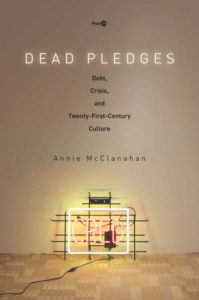 The Financial Turn
The Financial Turn
The financial crisis of 2007-8 has led to a veritable boom of finance novels, that subgenre of the novel that deals with “the economy”.[i] I am thinking of novels such as Jess Walter’s The Financial Lives of the Poets (2009), Jonathan Dee’s The Privileges (2010), Adam Haslett’s Union Atlantic (2010), Teddy Wayne’s Kapitoil (2010), Cristina Alger’s The Darlings (2012), John Lanchester’s Capital (2012), David Foster Wallace’s The Pale King (2012),[ii] Mohsin Hamid’s How To Get Filthy Rich in Rising Asia (2013), Nathaniel Rich’s Odds Against Tomorrow (2013), Meg Wolitzer’s The Interestings (2013)—and those are only a few.
Literary criticism has followed suit. Annie McClanahan’s Dead Pledges: Debt, Crisis, and Twenty-First Century Culture (published in the post-45 series edited by Kate Marshall and Loren Glass) studies some of those novels. It follows on the heels of Leigh Claire La Berge’s Scandals and Abstraction: Financial Fiction of the Long 1980s (2015) and Anna Kornbluh’s Realizing Capital: Financial and Psychic Economies in Victorian Form (2014), both of which deal with earlier instances of financial fiction. By 2014, McClanahan had already edited (with Hamilton Carroll) a “Fictions of Speculation” special issue of the Journal of American Studies. At the time of my writing, Alison Shonkwiler’s The Financial Imaginary: Economic Mystification and the Limits of Realist Fiction has just appeared, and no doubt, many more will follow. In the Coda to her book, La Berge mentions that scholars are beginning to talk about the “critical studies of finance” to bring together these developments into a thriving field.
Importantly, Dead Pledges looks not only at novels but also at poetry, conceptual art, photography, and film. Indeed, the “financial turn” involves more than fiction: J.C. Chandor’s Margin Call (2011), Costa-Gavras’ Capital (2012), Martin Scorcese’s The Wolf of Wall Street (2013), and Adam McKay’s The Big Short (2015) were all released in the aftermath of the 2007-8 crisis. American Psycho, the musical, premiered in London in 2013 and moved on to New York in 2016.
All of this contemporary work builds on and explicitly references earlier instances of thinking and writing about the economy, so it is not as if this interest in the economy is anything new. However, given the finance novel’s particular name one could argue that while the genre of the finance novel—understood more broadly as any novel about the economy–precedes the present, it is only during the financial era, which began in the early 1970s, and especially since the financial crisis of 2007-8 that it has truly come into its own. For the specific challenge that is now set before the finance novel is precisely to render the historic formation of “finance” into fiction. Critics have noted that such a rendering cannot be taken for granted. While capitalism has traditionally been associated with the realist novel (as La Berge and Shonkwiler at the outset of their edited collection Reading Capitalist Realism point out[iii]), literary scholars consider that capitalism’s intensification into financial or finance capitalism or finance tout court also intensifies the challenge to realism that some had already associated with global capitalism.[iv] Abstract and complex, finance exceeds what Julia Breitbach has observed to be some of the key characteristics of realism: “narration”, associated with “readable plots and recognizable characters”; “communication”, allowing “the reader to create meaning and closure”; “reference”, or “language that can refer to external realities, that is, to ‘the world out there’”; and “ethics”, “a return to commitment and empathy”.[v]
In the late 1980s, and just before the October 19th, 1987 “Black Monday” stock market crash, Tom Wolfe may still have thought that to represent finance, one merely had to flex one’s epistemological muscle: all novelists had to do, Wolfe wrote, is report—to bring “the billion-footed beast of reality” to terms.[vi] However, by the time Bret Easton Ellis’s American Psycho comes around, that novel presents itself as an explicit response to Wolfe,[vii] proposing a financial surrealism or what could perhaps be called a “psychotic realism” (Antonio Scurati) to capture the lives that finance produces. If (as per a famous analysis) late capitalism’s aesthetic was not so much realist but postmodernist, late late capitalism or just-in-time capitalism has only intensified those developments, leading some to propose post-postmodernism as the next phase in this contemporary history.[viii]
At the same time, realism seems to have largely survived the postmodernist and post-postmodernist onslaughts: in fact, it too has been experiencing a revival,[ix] and one that is visible in, and in some cases dramatized in, the contemporary finance novel (which thereby exceeds the kind of financial realism that Wolfe proposes). Indeed, one reason for this revival could be that in the aftermath of the financial crisis, novelists have precisely sought to render abstract and complex finance legible, and comprehensible, through literature—to bring a realism to the abstract and complex world of finance.
Given realism’s close association with capitalism, and its post- and post-postmodern crisis under late capitalism and finance, none of this should come as a surprise. Rather, it means that critics can consider the finance novel in its various historical articulations as a privileged site to test realism’s limits and limitations.
Finance, Credit, Mortgage
If Karl Marx’s celebrated formula of capital—M-C-M’, with money leading to money that is worth more via the intermediary of the commodity—is quasi-identified with the realist novel, the formula’s shortened, financial variation—M-M’, money leading to money that is worth more without the intermediary of the commodity[x]—has come to mark its challenges. Perhaps in part reflecting this narrative (though this is not explicitly stated in the book), Dead Pledges’ study of the cultural representations of finance starts with a discussion of the realist novel but quickly moves away from it in order to look elsewhere in search of representations of finance.
McClanahan’s case-studies concern the early twenty-first century, specifically the aftermath of the 2007-8 crisis. However, the historical-theoretical framework of Dead Pledges focuses on credit and debt. It extends some 40 years before that, to the early 1970s and the transformations of the economy that were set in motion then. Dead Pledges thus takes up the history of financialization, which is usually dated back to that time. Neoliberalism, which is sometimes confused with finance and shares some of its history, comes up a few times in the book’s pages but is not a key term in the analysis.
One could bring in various reasons for the periodization that McClanahan adopts, including—though with some important caveats—the Nixon administration’s unilateral decision in 1971 to abolish the gold standard, thus ultimately ending the Bretton Woods international exchange agreements that had been in place since World War Two and propelling the international markets into the so-called “Nixon shock.” However, in his key text “Culture and Finance Capital” Fredric Jameson already warned against the false suggestion of solidity and tangibility that such a reference to the gold standard (which was really “an artificial and contradictory system in its own right”, as Jameson points out[xi]) might bring. Certainly for McClanahan, who focuses on credit and debt and is not that interested in money, it would make sense to abandon so-called commodity theories of money and fiat theories of money—which have proposed that the origins of money lie in the exchange of goods or a sovereign fiat—for the credit or debt theory of money which, as per the revisionist analyses of for example David Graeber and Felix Martin,[xii] have exposed those other theories’ limitations. Indeed, McClanahan’s book explicitly mentions Graeber and other contemporary theorists of credit and debt (Richard Dienst, Maurizio Lazzarato, Angela Mitropoulos, Fred Moten and Stefano Harvey, Miranda Joseph, Andrew Ross) as companion thinkers, even if none of those writers is engaged in any detail in the book.
Since the 1970s, consumer debt has exploded in the United States and Dead Pledges ultimately zooms in on a particular form of credit and debt, namely the home mortgage. McClanahan inherits this focus from the collapse of the home mortgage market, which triggered the 2007-8 crisis. McClanahan rehearses the history, and the complicated technical history, of this collapse at various moments throughout the book. Although this history is likely more or less familiar to readers, the repetition of its technical detail (from various angles, depending on the focus of each of McClanahan’s chapters) is welcome. As McClanahan points out, home mortgages used to be “deposit-financed” (6). While there was always a certain amount of what Marx in Capital: Vol. 3 called “fictitious capital”[xiii] (“fiktives Kapital”) in play—banks can write out more mortgages than they actually have money for based on their credit-worthy borrower’s promise to repay (with interest)—the amount of fictitious capital has increased exponentially since the 1970s. More and more frequently mortgages are being funded not through deposits but “through the sale of speculative financial instruments” (6)—basically, through the sale of a borrower’s promise to repay. This development is enabled by the practice of securitization: many mortgages are bundled together into what is called a tranche, which is then sold as a financial instrument—a mortgage backed security (MBS) or collateralized debt obligation (CDO). These kinds of instruments, so-called derivatives, are the hallmark of what in Giovanni Arrighi’s terms we can understand as the phase of capitalism’s financial expansion (see 14). This refers to an economic cycle during which value is produced not so much through the making of commodities but through value’s “extraction” (as Saskia Sassen puts it[xiv]) beyond what can be realized in the commodity—in this particular case, through the creation and especially the circulation of bundles of mortgages.
As McClanahan explains, securitization is about “creating a secondary market” (6) for the sale of debt. The value of those kinds of debt-backed “commodities” (if we can still call them that) does not so much come from what they are worth as products—indeed, their value is dubious since for example the already mentioned tranches will include both triple A rated mortgages (mortgages with a low risk of default) and subprime mortgages (like the infamous NINJA mortgages that were granted to people with No Income, No Jobs, No Assets). Nevertheless, those MBSs or CDOs often still received a high rating, based on the flawed idea that the risk of value-loss was lessened by mixing the low risk mortgages with the high risk mortgages. What seemed to have mattered most was not so much the value of an MBS or CDO as product but their circulation, which is the mode of value-generation that Jasper Bernes among others has deemed to be central to the financial era. Ultimately, and while they brought the global financial system to the edge of collapse, they also generated extreme value for those who shorted those financial products. And shorted them big, as Adam McKay’s The Big Short would have it (Paramount, 2015; based on Michael Lewis’ 2010 book by the same title). By betting against them, the protagonists of Lewis’ and McKay’s story made an immense profit while everyone else suffered catastrophic losses.
“Dematerialization” alone and cognate understandings of finance as “performative” and “linguistic”[xv]—in other words, this story as it could be told using the abolition of the gold standard as the central point of reference—cannot tell the whole truth here, especially not since credit and debt can actually be found at the origin of money. However, through those historico-economic developments of credit and debt there emerges a transformed role of credit and debt in our societies, from a “form of exchange that reinforces social cohesion” (185) to “a regime of securitization and exploitable risk, of expropriation and eviction” (182). Dematerialization—or perhaps better, various rematerializations: for example from gold or real estate to securitized mortgage debt—is important but without the material specifics of the history that McClanahan recounts, it does not tell us all that much.
Echoing David Harvey’s description of the need for “new markets for [capital’s] goods and less expensive labor to produce them” as a “spatial fix” (Harvey qtd. 12), McClanahan reads the history summarized above as a “temporal fix” because “it allows capital to treat an anticipated realization of value as if it had already happened” (13). In 2007-8, of course, that fix turned out to be an epic fuck-up. McClanahan recalls Arrighi’s periodization (after Fernand Braudel) of capitalism as alternating “between epochs of material expansion (investment in production and manufacturing) and phases of financial expansion (investment in stock and capital markets)” (14) and notes that the 2007-8 crisis seems to have marked the end of the phase of financial expansion.
In Arrighi’s view, that would mean the time has come for the emergence of a new superpower, one that will step in for the U.S. as the global hegemon. A return of American (U.S.) greatness through a return to an era of material expansion (as the current U.S. President Donald J. Trump is proposing) appears unlikely within this framework: at best, it will have some short-lived, anachronistic success before the new hegemon arrives. However, will that new hegemon arrive? According to some, and McClanahan appears to align herself with those, the current crisis of the system “will not lead to the emergence of a new regime of capitalist accumulation under a different imperial superpower” (15). “Instead, it heralds something akin to a ‘terminal crisis’ in which no renewal of capital profitability is possible” (15). Does this then lead to an eternal winter, as Joshua Clover already asked?[xvi] Alternatively, are we finally done with those phases, and ready for something new?
The Novel: Scale and Character
If all of this has been theoretical so far, Dead Pledges’ four chapters stand out first as nuanced readings of works of contemporary culture. As McClanahan sees it, culture is the best site to understand debt as a “ubiquitous yet elusive social form” (2). By that, she does not mean we should forget about economic textbooks; but to understand debt as a “social form”, culture is the go-to place. McClanahan’s inquiry starts out traditionally, with a chapter about the contemporary realist novel. In it, she takes on behavioral economics, a subfield of microeconomics. Unlike macroeconomics, microeconomics focuses on individual human decisions. Whereas microeconomic models tend to assume rational agents, behavioralism does not: non-rational human decisions might cause or result from a market crisis.
What caused the 2007-8 crisis? There are multiple answers, and McClanahan shows that they are in tension with one another. One answer—the macroeconomic one–is that the crisis was the result of an abstract and complex financial system that caved in on itself. Such an explanation tends to avoid individual responsibility. On the other hand, microeconomics, and behavioralism in particular, blames the crisis on the bad decisions of a few individuals, which exculpates institutions. This seemed to be the dominant mode of explanation. In this explanation too, however, the buck seemed to stop nowhere: how many bankers went to jail for the catastrophic market losses they caused? This leads to a larger question: how should one negotiate, in economics, between the macro and the micro, between the individual and the system—how should one assign blame, enforce accountability? How should one regulate? How should one even think, and represent, the connections between systems and individuals?
One cultural form that has been particularly good at this negotiation is the novel, which tends to tell a macro-story through its representation of the micro, and so seeks “to capture the reality of a structural, even impersonal, economic and social whole” (24) while also considering “individual investors’ ‘personal impulses’” (31). This is what McClanahan finds in Martha McPhee’s Dear Money (2010), Adam Haslitt’s Union Atlantic, and Jonathan Dee’s The Privileges. These novels marry the macro- and the micro-economical; they accomplish what McClanahan presents as a scalar negotiation. However, one should note that in doing so, they keep the behavioralist model intact—for they suggest that individual bad decisions lie at the origin of macroeconomic events. McClanahan shows, however, that as novels Dear Money, Union Atlantic, and The Privileges take on that behavioralist remainder, in other words: the novel’s characteristic “focus on subjective experience and the meaningfulness of being a subject” (33), through their awareness of their place in the genealogy of the novel. McClanahan’s readings ultimately reveal that the novels she looks at cannot save the individual from what she terms “a kind of ontological attenuation or even annulment” (33) that comes with their account of the 2007-8 crisis. Out go the full characters of the realist novel. The crisis demands it.
What is left? The chapter culminates in a reading of Dee’s novel in which McClanahan cleverly suggests that the novel explores “the formal limits of sympathetic identification” and tells “money’s” story rather than the story of Adam and Cynthia “Morey” (51), who are the novel’s main characters. Thus, the novel is not so much about behavioralist psychology but about money itself. Capital is remade in the novel, McClanahan argues, “in the image of the human” (52), creating the uncanny effect of human beings who are merely stand-ins for money. Adam Morey/Money “has no agency, and he is all automaton, no autonomy. He has no interiority” (53). McClanahan does not note that this description places Adam in line with American Psycho’s “automated teller”[xvii] Patrick Bateman, who in a famous passage observes that while
there is an idea of a Patrick Bateman, some kind of abstraction, … there is no real me, only an entity, something illusory, and though I can hide my cold gaze and you can shake my hand and feel flesh gripping yours and maybe you can even sense our lifestyles are probably comparable: I simply am not there”.[xviii]
Like Bateman’s narrative voice, which echoes the abstraction of finance, The Privileges’ voice is that of “investment itself” (52), which swallows human beings up whole.
If the neoliberal novel, as per Walter Benn Michaels’ analysis (from which McClanahan quotes; 53) reduces society to individuals (and possibly their families, following Maggie Thatcher’s claim), The Privileges as a finance novel goes beyond that and “liquidat[es]” (53) individuals themselves. We are encountering here the terminal crisis of character that writes, in the guise of the realist novel, our financial present. Rich characterization is out. The poor character is the mark of financial fiction.
Yet, such depersonalization does not capture the full dynamic of financialization either. In Chapter 2, McClanahan draws this out through a discussion of the credit score and its relation to contemporary literature. Although one’s credit score is supposed to be objective, the fact that one can receive different credit scores from different agencies demonstrates that an instability haunts it—and resubjectifies, if not repersonalizes, it. McClanahan starts out with a reading of an ad campaign for a website selling credit reports that quite literally personalizes the scores one can receive. It probably comes as no surprise that one’s ideal score is personalized as a white, tall, and fit young man; the bad score is represented by a short balding guy with a paunch. He also wears a threatening hockey mask.
McClanahan suggests that what structures the difference here between the objective and the subjective, the impersonal and the personalized, is the difference between neutral credit and morally shameful debt. The former is objective and impersonal; the latter is subjective and personalized. The problem with this distinction, however, is not only that the supposedly objective credit easily lets the subjective slip back in (as is evident from the ad campaign McClanahan discusses); discussions of subjective debt also often lack quantitative and material evidence (when they ignore, for example, “the return in debt collection to material coercion rather than moral persuasion”; 57). Rather than showing how the personal can become “a corrective for credit’s impersonality” and how “objectivity [can become] a solution to the problem of debt’s personalization” (57)—debt always operates on the side of both–McClanahan considers how contemporary literature and conceptual art have turned those issues into “a compelling set of questions to be pursued” (57).
If in the finance novel, rich characterization is out, a question arises: what alternatives emerge for characterization at the crossroads of “credit, debt, and personhood” (57)? As McClanahan points out, there is a history to this question in the fact that “the practice of credit evaluation borrowed the realist novel’s ways of describing fictional persons as well as the formal habits of reading and interpretation the novel demanded” (59). The relation went both ways: “the realist novel drew on the credit economy’s models of typification … to produce socially legible characters” (59). Because “quantitative or systematized instruments for evaluating the fiscal soundness” of borrowers were absent, creditors used to rely “on subjective evaluations of personal character” to assess “a borrower’s economic riskiness” (59). Such evaluations used to take a narrative form; in other words, the credit report used to be a story. It provided a detail of characterization that readers of literature would know how to interpret. The novel—the information it provided, the interpretation it required—was the model for this, for the credit report.
Enter the quantitative revolution: in the early 1970s the credit report becomes a credit score, the result of “an empirical technique that uses statistical methodology to predict the probability of repayment by credit applicants” (63). Narrative and character go out the window; the algorithmically generated score is all that counts. It is the end of the person in credit. As McClanahan is quick to point out, however, the credit score nevertheless cannot quite leave the person behind, as the “creditworthiness” that the credit score sums up ultimately “remains a quality of individuals rather than of data” (65). Therefore, the person inevitably slips back in, leading for example to the behavioralist models that McClanahan discusses in Chapter 1. Persons become numbers, but only to inevitably return as persons. McClanahan’s reading of the credit score negotiates this interchange.
One can find some of this in Gary Shteyngart’s Super Sad True Love Story (2010). If critics have faulted the novel for its caricatures and stereotypes, which “[decline] the conventions of characterization associated with the realist novel” (68), McClanahan argues that Shteyngart’s characters are in fact “emblematic of the contemporary regime of credit scoring” (68). Shteyngart’s use of caricature “captures the creation of excessively particular data-persons”; his “use of stereotype registers the paradox by which a contemporary credit economy also reifies generalized social categories” (71). While the credit score supposedly does not “discriminate by race, gender, age, or class” (71), in fact it does. McClanahan relies in part on Frank Pasquale’s important work in The Black Box Society to note credit scoring systematizes bias “in hidden ways” (Pasquale qtd. 72)—hidden because black boxed. This leads McClanahan back to the ad campaign with which she opened her chapter, now noting “its racialization” (72). The chapter closes with a discussion of how conceptual art and conceptual writing about credit and debt have negotiated the issue of personalization (and impersonalization). If “the personal” in Chapter 1 was associated first and foremost with microeconomics and behavioralism (which McClanahan criticizes), McClanahan shows that it can also do “radical work” (77) in response to credit’s impersonalization as “a simultaneously expanded and denaturalized category … representing social relations and collective subjects as if they were speaking persons and thus setting into motion a complex dialectic between the personal and the impersonal” (77). She does this through a discussion of the work of conceptual artist Cassie Thornton and the photographs of the “We are the 99%” tumblr. Mathew Timmons’ work of conceptual writing CREDIT, on the other hand, plays with the impersonal to “provide an account of what constitutes the personal in the contemporary credit economy” (89).
Although McClanahan does not explicitly state this, I read the arch of her Chapters 1 and 2 as a recuperation of the personal from its negative role in behavioralism (as well as its naturalized, racist role in the credit scoring that is discussed in Chapter 2), and more broadly from microeconomics. Following Thornton in particular (whose art also features on the cover of Dead Pledges), McClanahan opens up the personal onto the macro of the social and the collective. In Dead Pledges, the novel and especially the realist novel turn out to be productive sites to pursue such a project due to the scalar negotiation and rich characterization that are typical of the genre—and in the credit-crisis novel both of those are under pressure. If the novel gradually disappears from Dead Pledges to give way to photography and film in Chapters 3 and 4, the concern with realism remains. Indeed, McClanahan’s book ultimately seems to want to tease out a realism of the credit-crisis era, and it is that project to which I now turn.
Foreclosure Photography and Horror Films
In Chapters 3 and 4, once the novel is out of the way, McClanahan’s brilliance as a cultural studies scholar finally shines. Dead Pledges’ third chapter looks at post-crisis photography and “foreclosure photography” in particular. The term refers to photography of foreclosed homes but evokes the very practice of photography itself, which depends on a shutter mechanism that closes—or rather opens very quickly–in order to capture a reality. This signals a complicity between foreclosure and photography that McClanahan’s chapter explores, for example in a discussion of photographs of forced eviction by John Moore and Anthony Suau, which allow McClanahan to draw out the complicities between photography and the police—but not just the police. She notes, for example, that “[t]he photographer’s presence on the scene is underwritten by the capacity of both the state and the bank to violate individual privacy” (114). Dead Pledges ties that violation of individual privacy to a broader cultural development towards what McClanahan provocatively calls “unhousing” (115), evident for example in how various TV shows allow the camera to enter into the private sanctuary of the home to show how people live. Here, “the sanctity of domestic space [is defended] precisely by violating it” (115). In parallel, “sacred” real estate, the financial security of the domestic property has become transformed—violated—by the camera seeking to record foreclosure. The home now represents precarity. This development happened due to the creation of mortgage backed securities, which turned real estate into liquidity and the home into an uncanny abode.
The chapter begins with a comparative discussion of photographs in which the home is “rendered ‘feral’—overrun by nature” (103). McClanahan considers the narratives that such photography evokes: one is that of the disintegration of civilization into a lawless zone of barbarism—the story of the home gone wild. Looking at the mobilization of this narrative in representations of Detroit, she discusses its biopolitical, racial dimensions. Often the economic hardship that the photographs document is presented as something that happens to other people. But the being of debt today is such that it is everywhere—in other words the “othering” of the harm it produces (its location “elsewhere”) has become impossible. So even though the photographs McClanahan discusses “represent the feral houses of the crisis as the signs of racial or economic Otherness, these photographs ultimately reveal that indebtedness is a condition more widely shared than ever before, a condition that can no longer be banished to the margins of either national space or of collective consciousness” (113). It is us—all of us.
The last two sections of the chapter deal with the uncanny aspects of foreclosure photography—with the foreclosed home as the haunted home and the uncanny architectural landscape as the flipside of the financial phase that was supposed to “surmount” (135) the crisis of industrial production but actually merely provided a temporal fix for it. Ghost cities in China—cities without subjects, cities whose assets have never been realized, marking the failed anticipation of credit itself–are the terminal crisis of capital. The uncanny, in fact, becomes a key theoretical focus of this chapter and sets up the discussion of horror films in the next: real estate (in other words, the familiar and secure), becomes the site where the foreign and unstable emerges, and as such the uncanny becomes a perfect concept for McClanahan to discuss the home mortgage crisis.
Far from being real estate, the house, and in particular the mortgaged home, is haunted by debt; so-called “homeowners” are haunted by the fact that the bank actually “owns” their home. Property is thus rendered unstable and becomes perceived as a real from which we have become alienated. In McClanahan’s vision, it even becomes a hostile entity (see 127). At stake here is ultimately not just the notion of property, but a criticism of property and “the inhospitable forms of domestic life produced by it” (105), an undermining of property—and with it a certain kind of “family”–as the cornerstone of liberalism. If McClanahan is critical of our era’s sanctification of the private through a culture of unhousing, her response is not to make the case for housing but rather to use unhousing to expose the fundamental uncanniness of property. With that comes the profanation (as opposed to the sanctification) of the private (as a criticism of inhospitable forms of domestic life). The domestic is not sacred. Property is not secure. Time to get out of the fortress of the house and the violence it produces. If the housing crisis has produced the precarization of the house, let us use it to reinvent domestic life.
Given the horror film’s long-standing relationship with real estate—think of the haunted house–it was only a matter of time before the 2007-8 crisis appeared in contemporary horror films. And indeed, in the films that McClanahan looks at, it does appear—as “explicit content” (151). One has to appreciate here McClanahan’s “vulgar” approach: she is interested in the ways in which the horror films she studies “speak explicitly to the relationship between speculation, gentrification, and the ‘opportunities’ presented to investors by foreclosure” (151). Unlike for example American Psycho, which borrows a thing or two from the horror aesthetic, McClanahan’s horror flicks do not shy away from the nuts and bolts of finance; instead, they “almost [obsessively include] figures and terminology of the speculative economy in real estate” (151). This leads McClanahan to suggest that as horror films, they have “all the power of reportage”: they offer “a systematic account rendered with all the explicit mimetic detail one would expect of a realist novel” (151). At the same time, they do not do the kind of reporting Tom Wolfe was advocating back when: indeed, “they draw on the particular, uncanny capacity of the horror genre to defamiliarize, to turn ideological comfort into embodied fear” (151). McClanahan emphasizes, with a nod to Jameson (and his appropriation of Lévi-Strauss’ account of myth[xix]), that this is not just a performance of the “social contradictions” that always haunt narrative’s “imaginary solutions” (151). Instead, the films “oscillate between the imagined and the real or between ‘true stories’ and ‘crazy’ nightmares” (151). There are contradictions here both at the level of form and of content—both representational and material, McClanahan writes—and they remain without resolution. The credit-crisis era requires this sort of realism.
Darren Lyn Bouseman’s Mother’s Day (Anchor Bay, 2010), for example, a remake of Charles Kaufman’s 1980 film, oscillates between competing understandings of property: “as labor and sentimental attachment”; “as nontransferable value and the site of hospitality”; “as temporal and personal”; “as primarily a matter of contingent need” (157). If those all contradict each other, McClanahan points out that what they have in common is that “they are all incompatible with the contemporary treatment of the house as fungible property and liquid investment” (157). Upkeep, sentimental investment, and use all become meaningless when a hedge fund buys up large quantities of foreclosed homes to make profit in renting. Such a development marks the end of “ownership society ideology in the wake of the crisis” (158). Like Crawlspace (Karz/Vuguru, 2013), another film McClanahan discusses, Mother’s Day reveals a strong interest in the home as fixed asset, and the changes that his asset has undergone due to securitization. Indeed, the two other films that McClanahan looks at, Drag Me to Hell (Universal, 2009) and Dream Home (Edko, 2010), are “more specifically interested in real estate as a speculative asset and in the transformation of uncertainty into risk” (161-2).
By the time Dream Home ends, with an explicit reference—from its Hong Kong setting–to “America’s subprime mortgage crisis” (170), it is hard not to be entirely convinced that with the horror film, McClanahan has uncovered the perfect genre and medium for the study of the representation of the home mortgage crisis. It is here that realism undergoes its most effective transformation into a kind of horrific realism or what I propose to call realist horror, an aesthetic that, like so much else when it comes to finance, cannot be easily located but instead oscillates between different realms. Indeed, if Dream Home provides key insights into the home mortgage crisis in the U.S., it is worth noting that it does so from its Chinese setting, which McClanahan takes to indicate that many of the changes that happened as part of financialization from the 1970s to the present in the U.S. in fact “occurred first in Asia” (174). This opens up the American (U.S.) focus of McClanahan’s book onto the rest of the world, raising some questions about the scope of the situation that Dead Pledges analyzes: how global is the gloomy, even horrific picture that McClanahan’s book paints? This seems particularly important when it comes to imagining, as McClanahan does in the final part of her book, political responses to debt.
Debt and the Revolution
While the home mortgage is McClanahan’s central concern, Dead Pledges closes with a political Coda about student debt. If McClanahan returns here to student loans (a topic that she had already addressed in Chapter 2), it is because they are perhaps the representative example of the securitized debt markets that she has discussed. Given the staggering amount of student debt, the low-regulation environment of student loans, and the default rate on student loans, it is likely that the next major market crash will result from the collapse of the securitized student debt market. It is worth noting, indeed, that some are already shorting this market in the hopes of making a profit from its collapse a few years down the line (The Bigger Short, anyone?). In this situation, McClanahan proposes “sabotage”: like several others, most prominently the Strike Debt movement, she is calling on students to stop paying their debts. As the Strike Debt movement puts it: “If you owe the bank $10,000, you’re at the mercy of the bank. If you owe the bank $10 million, the bank is at your mercy”.[xx] Today, banks are at the mercy of students through the massive amounts of student credit that have been extended.
McClanahan arrives at this politics of sabotage through her discussion of the collapse of the home mortgage market, and specifically of foreclosure. In the first part of her Coda, she discusses how people have responded to their homes being foreclosed by “acts of vandalism”, like “punch[ing] holes in the walls”, leaving “dead fish to rot in basements”, or breaking “pipes to flood their houses with water or sewage”, which she singles out as a “clever” way of “turning the problem of their home’s asset illiquidity on its head” (186). If these are acts of sabotage, it is because they “[remove] commodities from circulation or [block] the paths by which they (and money) circulate” (186). McClanahan embraces this tactic. From this vantage point, one can understand why, as someone reported to me recently after a visit to Greece, the banks there are holding off on foreclosing on those who have defaulted on their mortgages: by keeping the owners in their homes, the banks are trying to guarantee the protection of their assets—this is clearly the better option especially in view of the absence of renter or buyer demand for the apartments or homes whose owners have defaulted. For the moment, the banks in Greece are paying their borrowers for the maintenance of the bank’s assets.
A couple of things are worth noting: first, “vandalism” or the destruction of an object does not necessarily coincide with the destruction of that object as a commodity. Indeed, if to destroy the object as commodity is to take it out of circulation—as McClanahan, following Bernes (following Marx), argues (186)—then the question is first and foremost how to block that circulation—and that might involve acts of vandalism, or not. In fact, one might imagine the situation in Greece, which involves labor being invested in the upkeep of a home, ultimately leading to a property claim—to taking the home out of the circulation that makes the bank its money. McClanahan considers such an understanding of property in her reading of Mother’s Day in Chapter 4. However, McClanahan is taking aim at the root of property (as becomes clear in both Chapters 3 and 4), and so the latter might not be a satisfactory solution since it keeps the notion of property intact. In addition, one might want to ask whether the home is the appropriate target for the vandalism? Why not sabotage the bank’s plumbing instead? Leave some fish to rot in the bank’s basement?
Secondly, in the case of student loans, what is the asset to vandalize? The asset that students acquire through loans is “education.” It is an asset that the bank cannot reclaim although of course the diploma that formalizes it can be and has been taken away. But it is not inconceivable that, if the home mortgage crisis is the model here, the institutions and people providing an education will be vandalized: universities, professors, administrators—rather than the banks. And some (Trump University comes to mind) would certainly deserve it. At my own (private arts) institution, where tuition is currently set at a whopping $46,830, I have seen posters in which students bitterly thank the university president for their student debt or claim that the only thing that unites them as students is their debt. If the students look at the institute’s budget more closely, they are able to see that it is tuition-driven: specifically, the pie-chart clearly shows that (debt-based) tuition pays the faculty’s salaries. This pitches the students not only against the university president or other administrators (whose salaries, needless to say, far exceed those of the faculty) but ultimately against the faculty. McClanahan also notes that faculty retirement may also be involved in this: Student Loan Asset Backed Securities (or, in finance’s inexhaustible generation of acronyms, SLABS) are “tranched and sold to institutional investors, including many pension funds” and so “it’s possible for a professor at a university to be indirectly invested in the debt of her own students” (189). Not just in the present, through their salary, but also in the future, for their retirement.
It is important to argue about student debt, and some faculty—like McClanahan–are bringing that argument into their classrooms. But it will be interesting to see how that develops once the student debt market collapses and faculty salaries and retirement implode. Kant’s answer to the question “What is Enlightenment?” was famously split between “Argue all you please” and “Obey.” What happens if, in this particular case, the students stop obeying? Unless they identify the agent of their subjection correctly—faculty? administrator? university president? university? bank? government? President?–, it might ring the death knell of the U.S. university system. Of course, that may have been the project all along–now with the students as its driving force.
It is the political dimension of McClanahan’s book, which is somewhat disavowed in the introduction–McClanahan notes early on that “Dead Pledges is not a work of political economy” (15)–but then becomes prominent in the Coda, that may leave some readers frustrated. This is, on the one hand, because the Coda makes a comparative move from home mortgages to student loans that does not come with the nuanced discussion of economics that McClanahan develops elsewhere in the book (there is no consideration, for example, of how CDOs and SLABS are different: does it make sense to short SLABS? Why? Why not?). However, the economic specifics may be important when trying to decide on the most effective political response. The specific response that Dead Pledges offers—sabotage—may also leave some readers frustrated. While sabotage can be effective as a politics that would break financialization’s extraction of value through circulation, it remains, ultimately, a negative intervention that temporarily interrupts or destroys (perhaps in some cases definitively) its targets. But it seems obvious that as far as politics goes, that response can hardly be sufficient; some kind of positive engagement would be required to imagine the world that will come after it. It seems one would need to ask about the “affirmative”[xxi] dimension of the sabotage that is proposed here.
In a review[xxii] of Wendy Brown’s book Undoing the Demos: Neoliberalism’s Stealth Revolution,[xxiii] McClanahan has criticized Brown on a number of counts, first of all because of her largely negative description of the collective as something that neoliberalism destroys; and second, because through that description, Brown uncritically projects a pre-neoliberal collective that was somehow unaffected by economic pressures. Sarah Brouillette, with whom McClanahan recently teamed up for her response to the Yale hunger strike,[xxiv] has made a similar point.[xxv] As far as positive descriptions of collectivity go, however, McClanahan’s sabotage may also leave one dissatisfied. Furthermore, one may wonder whether the turn to sabotage as a politics is not partly a consequence of Dead Pledges’ focus on the United States. When considering political responses to the debt crisis, it might be the limits and limitations of that focus—a version of the “there is no alternative” that is often associated with neoliberalism–that prevents for example any consideration of, say, the state’s potentially positive roles in processes of financial regulation or even wealth redistribution. Is sabotage the only politics that the left has left in the U.S.? Might not other parts of the world—for example, certain countries in Europe, certain countries in Latin America—offer alternatives from which the left in the U.S. could learn? I am not being naïve here about what I am proposing: it would require fundamental political changes in the U.S. for this to come about. But again, are those changes entirely beyond the American (U.S.) left—so much so that the political imaginary stops at sabotage? Who was it again that rhymed “sabotage” with “mirage”? Sabotage should target the mirage, to be sure; but it raises the question: does their rhyme also evoke sabotage’s complicity with the mirage? Has leftist politics really come down to leaving dead fish to rot in the basements of what used to be our homes? Of course, it may be unfair to expect that those who are defaulting on their mortgages become the agents of the leftist revolution. But what about the students who emerge as the political subjects of our time at the end of McClanahan’s book? Let us focus, post-sabotage, on what other universities they might imagine–what other states.
I am thinking of what another revolutionary says during that famous rooftop conversation in Gillo Pontecorvo’s The Battle of Algiers (Rizzolo, Rialti Pictures, 1966):
It’s hard to start a revolution. Even harder to continue it. And hardest of all to win it. But, it’s only afterwards, when we have won, that the true difficulties begin.
Work in critical finance studies often recalls how it has become easier for us to imagine the end of the world than the end of capitalism.[xxvi] Point taken. But Pontecorvo’s film can help one adjust this position: yes, it is hard to imagine the end of capitalism; but it is even harder to imagine the world that will come after it.
There is probably no point in worrying, as I will admit I do, about that world and the “true difficulties” that it will bring. Such worrying may prevent one from starting a revolution in the first place. Best to focus on the battle at hand. Certainly, McClanahan’s Dead Pledges provides the perfect impetus.
I would like to thank Paul Bové and Sarah Brouillette for their generous editing of this review.
Notes
[i] In an article titled “The Plutocratic Imagination”, Jeffrey J. Williams notes for example that “[s]ince the mid-2000s there has also been a spate of novels foregrounding finance” (Williams, “The Plutocratic Imagination.” Dissent 60:1 (2013): 96.
[ii] David Foster Wallace may appear to be the odd one out in this list but Jeffrey Severs’ recent David Foster Wallace’s Balancing Books: Fictions of Value (New York, Columbia UP, 2017) justifies his inclusion.
[iii] Berge, Leigh Claire La and Alison Shonkwiler, eds. Reading Capitalist Realism. Iowa City: U of Iowa P, 2014. 1.
[iv] One can think here of Alberto Toscano and Jeff Kinkle’s book Cartographies of the Absolute (Winchester, Zero Books: 2015), which took its inspiration from Fredric Jameson’s work on these issues.
[v] Breitbach, Julia. Analog Fictions for the Digital Age: Literary Realism and Photographic Discourses in Novels after 2000. Rochester: Camden House, 2012. 8.
[vi] Wolfe, Tom. “Stalking the Billion-Footed Beast: A Literary Manifesto for the New Social Novel.” Harper’s Magazine Nov. 1989, 45-56. Here 52. Using a nickname that was used on the Salomon Brothers trading floor to refer to those who had made a monster bonds trade, Michelle Chihara aptly termed this kind of realism “big swinging dick realism” in a review of La Berge and Kornbluh’s books about financial fiction. See: Chihara, Michelle. “What We Talk About When We Talk About Finance.” Los Angeles Review of Books, 09/18/2015, accessible: https://lareviewofbooks.org/article/what-we-talk-about-when-we-talk-about-finance/.
[vii] See, for example: Berge, Leigh Claire La. “The Men Who Make the Killings: American Psycho and the Genre of the Financial Autobiography”. In: Berge, Scandals and Abstraction: Financial Fiction of the Long 1980s. Oxford: Oxford UP, 2015. 113-147. Here in particular 139.
[viii] Nealon, Jeffrey T. Post-Postmodernism: Or, The Cultural Logic of Just-In-Time Capitalism. Stanford: Stanford UP, 2012. The famous analysis evoked in the previous part of the sentence is of course Fredric Jameson’s.
[ix] Kornbluh’s book, among others, testifies to this: Kornbluh, Anna. Realizing Capital: Financial and Psychic Economies in Victorian Form. New York: Fordham UP, 2014.
[x] Note that Marx already singled out this shorter version as the formula for “interest-bearing capital”, a situation in which money begets more money without the intermediary of the commodity: Marx, Karl. Capital: Vol. 1. Trans. Ben Fowkes. New York: Penguin, 1990. 257. A discussion of M-M’ as the financial variation of the general formula of capital can be found for example in: Marazzi, Christian. Capital and Language: From the New Economy to the War Economy. Trans. Gregory Conti. Los Angeles: Semiotext (e), 2008.
[xi] Jameson, Fredric. “Culture and Finance Capital.” In: The Cultural Turn: Selected Writings on the Postmodern 1983-1998. New York: Verso, 2009. 154.
[xii] Graeber, David. Debt: The First 5,000 Years. New York: Melville House, 2011; Martin, Felix. Money: The Unauthorized Biography—From Coinage to Cryptocurrencies. New York: Vintage, 2015.
[xiii] Marx, Karl. Capital: Vol. 3. Trans. David Fernbach. New York: Penguin, 1991. 596.
[xiv] Sassen, Saskia. Expulsions: Brutality and Complexity in the Global Economy. Cambridge (MA): Harvard UP, 2014.
[xv] See, for example, the already mentioned book by Marazzi or also: Berardi, Franco “Bifo.” Precarious Rhapsody: Semiocapitalism and the Pathologies of the Post-Alpha Generation. London: Minor Compositions, 2009; Berardi, The Uprising: Poetry and Finance. Los Angeles: Semiotext (e), 2012.
[xvi] Clover, Joshua. “Autumn of the System: Poetry and Financial Capital.” JNT: Journal of Narrative Theory 41:1 (2011): 34-52.
[xvii] This is how La Berge has perceptively analyzed American Psycho’s mode of narration: Berge, Scandals, 136.
[xviii] Ellis, Bret Eason. American Psycho. New York: Vintage, 1991. 376-377.
[xix] See: Jameson, Fredric. The Political Unconscious: Narrative as a Socially Symbolic Act. Ithaca: Cornell UP, 1981.
[xx] McKee, Yates. “DEBT: Occupy, Postcontemporary Art, and the Aesthetics of Debt Resistance.” South Atlantic Quarterly 112:4 (2013): 784-803. Here 788.
[xxi] I borrow the notion of “affirmative sabotage” from Gayatri Chakravorty Spivak. See, for example: Evans, Brad (interview with Gayatri Spivak), “When Law is Not Justice”, 07/13/2016, accessible: https://www.nytimes.com/2016/07/13/opinion/when-law-is-not-justice.html?_r.
[xxii] McClanahan, Annie. “On Becoming Non-Economic: Human Capital Theory and Wendy Brown’s Undoing the Demos.” Theory & Event, forthcoming.
[xxiii] Brown, Wendy. Undoing the Demos: Neoliberalism’s Stealth Revolution. New York: Zone Books, 2016.
[xxiv] Brouillette, Sarah, Annie McClanahan, and Snehal Shingavi. “Risk and Reason/The Wrong Side of History: On the Yale University Unionization Efforts”, 05/16/2017, accessible: http://blog.lareviewofbooks.org/essays/risk-reasonthe-wrong-side-history-yale-university-unionization-efforts/.
[xxv] Brouillette, Sarah. “Neoliberalism and the Demise of the Literary.” In: Huehls, Mitchum and Rachel Greenwald-Smith, eds. Neoliberalism and Contemporary Literature. Baltimore: Johns Hopkins UP, forthcoming. The uncorrected page proofs with which I am working are numbered 277-290.
[xxvi] The statement is usually attributed to Fredric Jameson.
Arne De Boever teaches American Studies in the School of Critical Studies at the California Institute of the Arts, where he also directs the MA Aesthetics and Politics program. He is the author of States of Exception in the Contemporary Novel (2012) Narrative Care (2013), and Plastic Sovereignties (2016), and a co-editor of Gilbert Simondon (2012) and The Psychopathologies of Cognitive Capitalism (2013). He edits Parrhesia and the Critical Theory/Philosophy section of the Los Angeles Review of Books and is a member of the boundary 2 collective. His new book, Finance Fictions, is forthcoming with Fordham University Press.
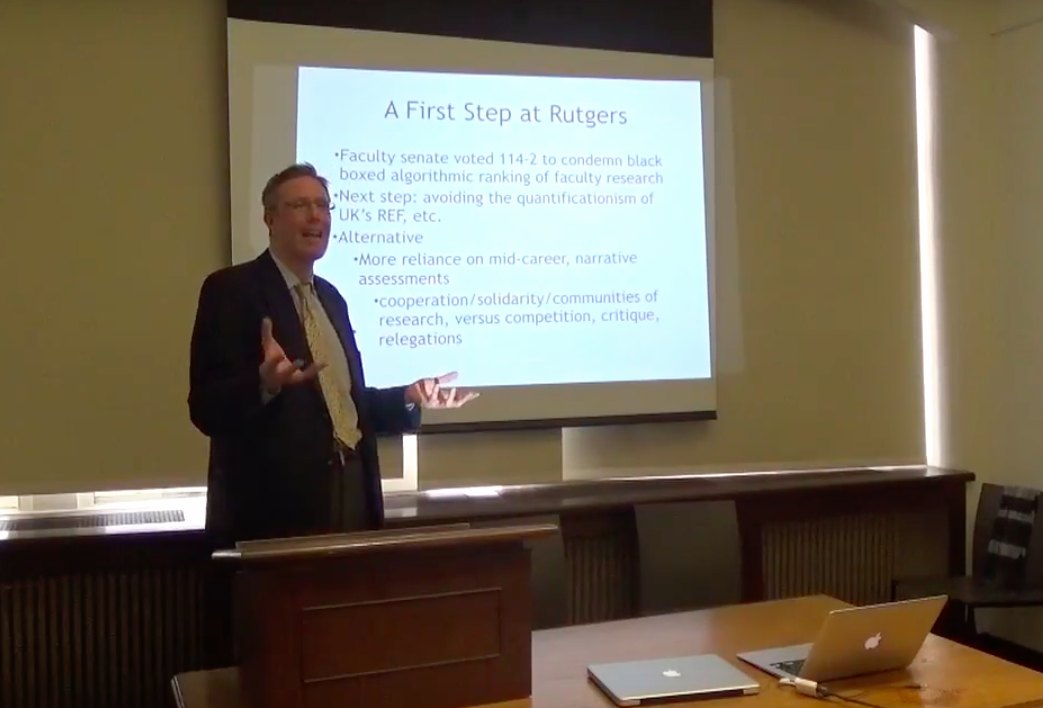
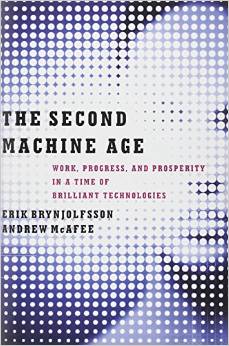


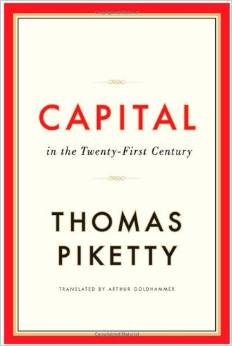
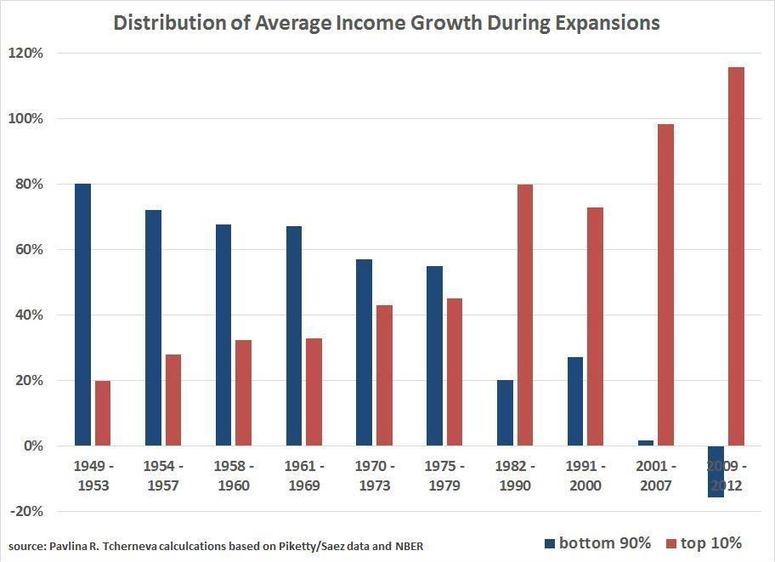
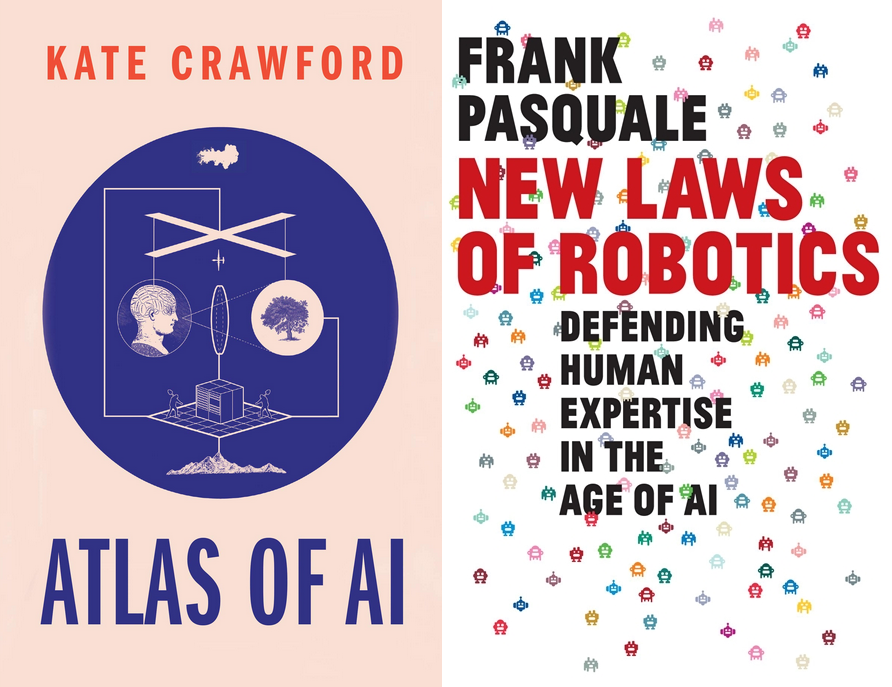


 The Financial Turn
The Financial Turn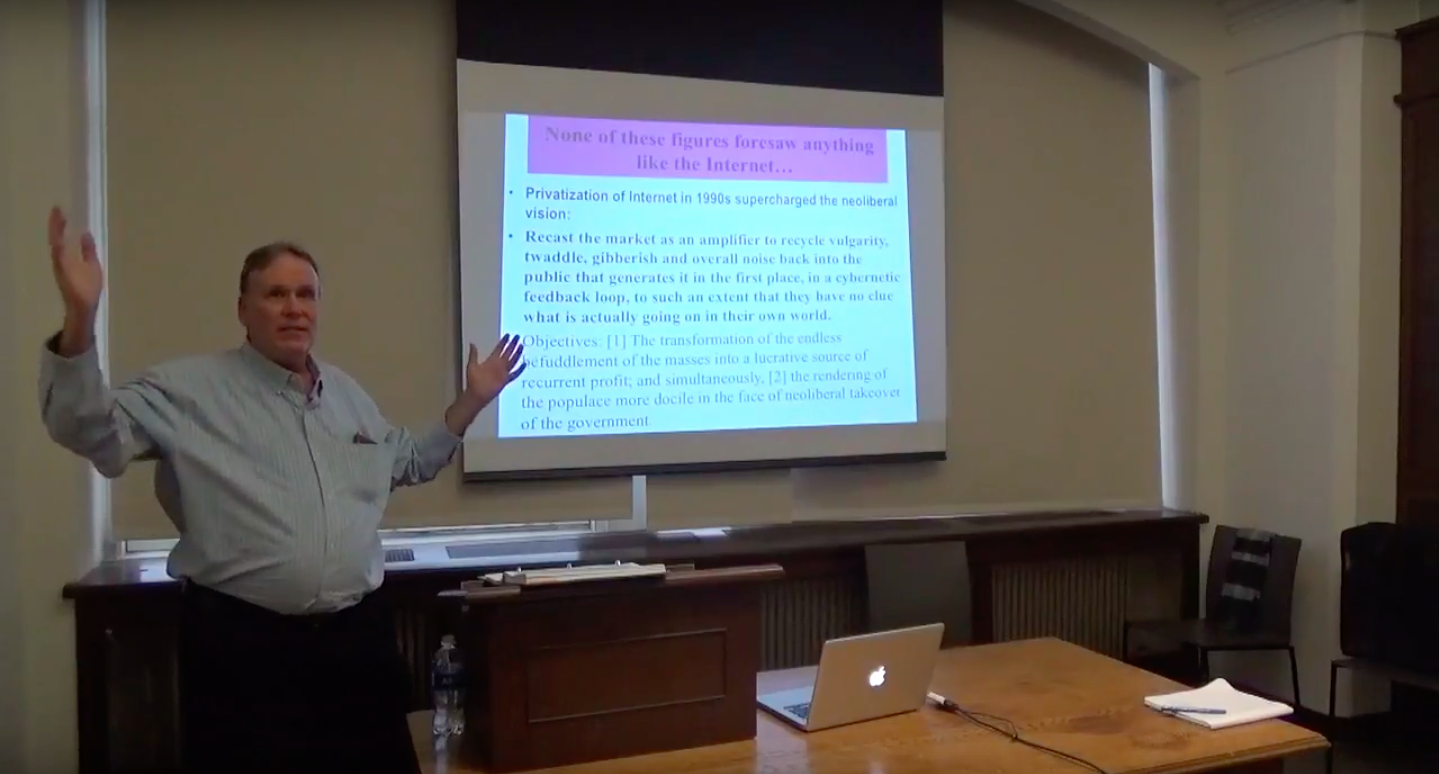

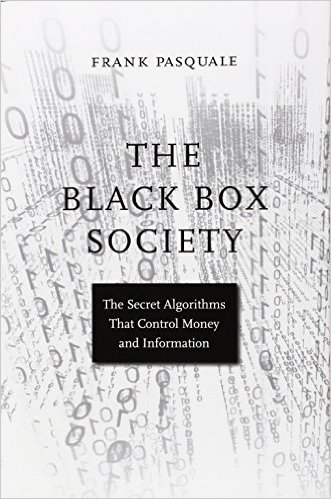
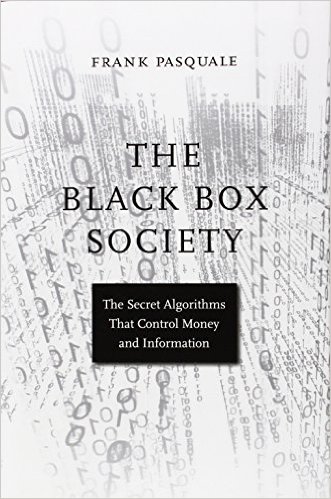 a review of Frank Pasquale, The Black Box Society: The Secret Algorithms That Control Money and Information (Harvard University Press, 2015)
a review of Frank Pasquale, The Black Box Society: The Secret Algorithms That Control Money and Information (Harvard University Press, 2015)